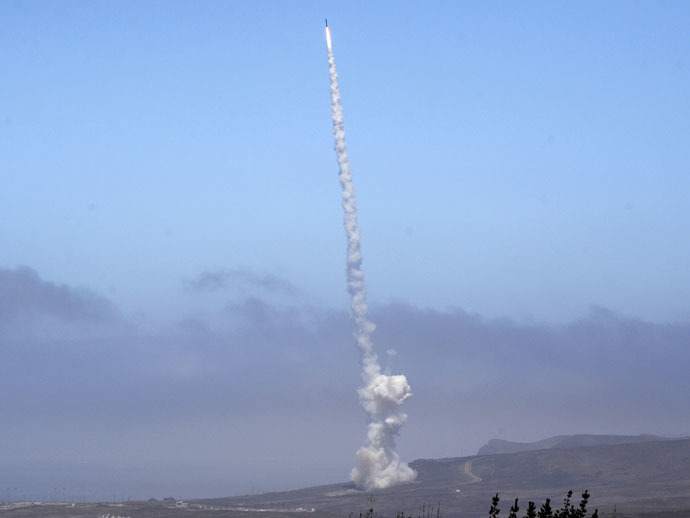US SBX radar ‘white elephant, useless project’

The huge floating X-Band Radar only got funded as such projects makes it look the Defense Department is getting something for its money said senior Linley Group analyst Loring Wirbel. Aegis cruiser radars are more effective, cheaper and smaller.
The US Pentagon has wasted $10 billion on a missile defense project, the sea-based X-Band Radar (SBX), which turned into a major flop, according to media reports. Moreover the missile defense failures appear to also threaten US security.
RT:What do you make of US missile defense project failures?
LW: What is funny is that the missions never really looked like they were going to be successful and yet the budget of the Missile Defense Agency has not changed over time except to go up. It actually hit its highest point in the later Bush years - $9 billion a year. But even under Obama we are now seeing next year they are asking for $8 billion. So every year they get the same allocation of about $7-10 billion per year and they also say “Oh, the right technology is just around the corner”. Somehow no one in Congress asks the right questions to say “Is this a genuine national defense capability?” As long as they can show they have radars deployed and missiles deployed, the members of Congress think they are getting some kind of technology for their money.
RT:Do you think the authorities could reduce the spending by launching the missile defense projects gradually rather than all together?
LW: Yes, as a matter of fact that is a little bit of what happened in Poland and Romania because they were going to get very big missiles called the GBI missiles and then they became a program to replace that with a smaller missile called the SM-3. Now it’s unclear whether any radar, any missiles would be deployed in Poland because it is seen as provocative. I think that no one is really set down to ask “What are the goals here?” Ronald Reagan gave money to people like Edward Teller and said “Build an X-ray laser in space”. It was a crazy idea, no one believed that, and yet they got funding. Since then there have been programs for space-based lasers and air-based lasers. None of them looked like they would ever accomplish anything yet they still got funding. Now I think what is happening is that people are looking at smaller ground-based rockets and radars that could help with the problem particularly of smaller missiles from third world nations. But so far that budget is still around $8 billion a year.

RT:L. David Montague, a former president of missile systems for Lockheed Corporation said of the SBX radar that "it should not have been even started.” Why was it even started when it seems now it was doomed from the start?
LW: There is a very large sea-based X-Band Radar that floats around in the ocean. I think why it got funded is because it’s a large project that looks like the Defense Department is getting something for its money. The radar that is onboard the Aegis cruisers are far more effective, cheaper and smaller. But the X-Band Radar is something massive, the size of a huge building and it lets people say “Here’s what we are spending our money on.” I think that X-Band Radar could be an interesting test program for smaller X-Band Radars that would go into Europe, but the minute you send those X-Band Radars into Europe that would create a whole new provocative political issue. So I think that a person who called that a white elephant or a useless project was probably mostly correct.
Politicians in US have higher expectations than science can allow
Paul Heroux from the Institute for Defense and Disarmament Studies suggests the X-Band Radar project failed as the science has not caught up with the expectations.
RT:This project was meant to become an indestructible shield for United States' defense, but it has failed to accomplish its basic goals. Could you, please, tell us why it failed?
Paul Heroux: It failed because the science has not caught up with the expectations. The expectation is that we’ll be able to defend against any type of ICBM coming from potential threats such as North Korea or Iran. And the politicians in Washington basically have higher expectations than science is allowing for at this point of time.
RT:How do you think this failure is going to influence the US defense capabilities?
PH: The US defense capabilities are generally very strong. This is something that needs to be done because it’s a science-based and an engineering-based initiative, it needs to be done at a pace that would allow it to keep up with the technology that’s available. We spent a lot of money, billions of dollars on these programs, these missile defense programs are done under the right intentions, however they can’t be rushed. The technology available has to be developed and that’s what a lot of this money, the contracts with companies like Boeing and Raytheon… that’s where a lot of money goes to, to actually developing the technologies because the idea has been in existence and now we are trying to develop it. So it really depends on a number of factors in terms of what is going to happen in future defense technology. If there is a legitimate and valid threat coming from another country in a form of an ICBM that will potentially reach the US because only a couple of countries can actually reach the US with their missiles, if an aggressor actually has a capability then you might see that become a higher priority in the budget process. That’s essentially what this is, a budget issue - whether or not we continue to fund something. It also is going to depend on whether we have a Republican or a Democrat President in office. Traditionally Republicans have liked to push these initiatives and Democrats have liked to be a little more cautious with the spending on these particular types of research and development projects.
READ MORE: $10 bln down the drain? US spends billions on 'ineffective' missile defense systems
RT:As news agencies have mentioned “Missile Defense Agency officials latched onto exotic, unproven concepts without doing a rigorous analysis of their cost and feasibility.” Do you think that the authorities could reduce the spending by launching the projects gradually rather than altogether?
PH: I think it could be and it should be done gradually as opposed to precipitously. Proper development of the technology takes time; it’s not something that can be rushed. Engineering and science initiatives develop with trial and error. And if we deploy a system that is not ready to be deployed, it’s not going to be effective at all and it’s going to appear to be waste of money. But the money that is spent is a process, and if not enough money is spent the process could fall short. However, this is not necessarily an issue where we just have to keep throwing more money after the problem because this is an opportunity cost. There are other systems that could be and should be implemented that have been found to be effective. They have already been developed but we are looking to increase our capabilities. Isn’t that something we have to be cognizant about?
RT: This project was also designed to defend the United States from future sophisticated surprise attacks from North Korea or supposedly from Iran. What do you think America's Department of Defense is going to do to cover this hole in its defense?
PH: The idea that there is a missile threat from Iran or North Korea is slightly misplaced because at present neither country has the capability of reaching the US with an ICBM, with the exception of North Korea maybe being able to reach Alaska. But Iran doesn’t have a capability of doing that. So what we really have to consider is “Is there a realistic threat?” Now I think that the Director of National Intelligence spoke just recently talking about how North Korea was trying to develop a capability to reach the US and that’s something that is a concern and he wouldn’t be doing his job if he didn’t raise this issue, but at present there is no actual threat that can realistically target the US. In North Korea they have a few weapons systems but they have largely not been tested and the claims that they have don’t really match up to the reality and to what we’ve been able to see that they can deliver on.
The statements, views and opinions expressed in this column are solely those of the author and do not necessarily represent those of RT.
The statements, views and opinions expressed in this column are solely those of the author and do not necessarily represent those of RT.












